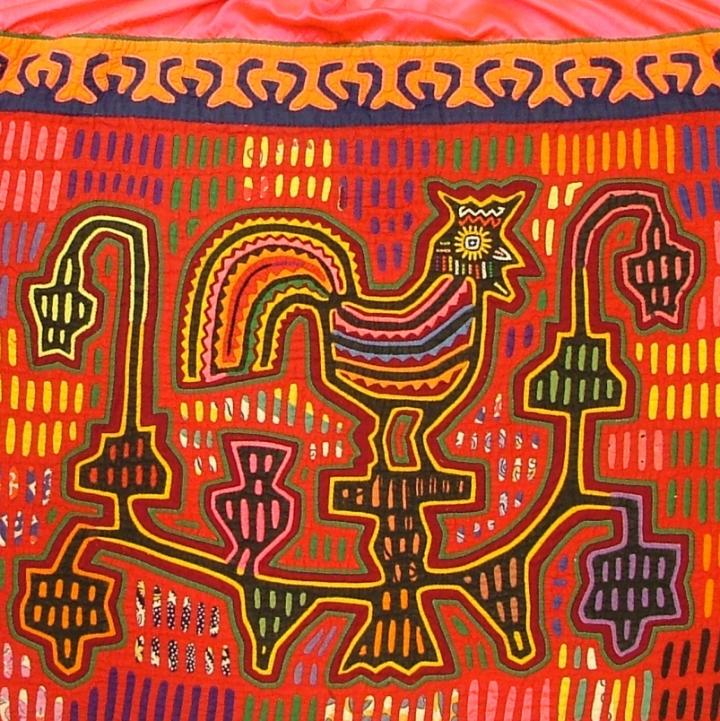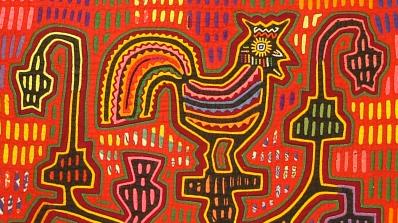Molas
LEARNING TO LOOK LESSON:
This resource will allow you to lead your students through careful observation and analysis of this piece.

Unknown artist, Ubigantupu, Kuna peoples, Kuna Yala, Panama, Mola, mid-20th century, cotton cloth and thread. The Alice Cox Collection, given by her daughter Mrs. Barbara Vallarino; 177.9.25740.
Based on the Learning to Look method created by the Hood Museum of Art. This discussion-based approach will introduce you and your students to the five steps involved in exploring a work of art: careful observation, analysis, research, interpretation, and critique.
HOW TO USE THIS RESOURCE
1. Print out this document for yourself.
2. Read through it carefully as you look at the image of the work of art.
3. When you are ready to engage your class, project the image of the work of art on a screen in your classroom.
4. Use the questions provided below to lead the discussion.
INTRODUCTION
Explain to students that a mola (pronounced MO-la) means blouse or clothing in the Kuna language. It is also the word used to describe colorful panels made of cotton fabric and thread created by the Kuna women of Panama. These cloth panels are attached to the fronts and backs of women's blouses. Molas have become part of the cultural dress of Kuna women, which also includes patterned wrap-around skirts, gold nose rings, and beaded arm and leg bands. Molas are still worn by Kuna women as both everyday attire and on special occasions. They wear them to celebrate their culture, their interests, and their creativity.
Step 1. Close Observation
Ask students to look carefully and describe everything they see. Start with broad, open-ended questions like:
* What do you notice about this mola?
* What else do you see?

Then become more and more specific as you guide your students’ eyes across the work with questions like these:
What do you notice about:
* The colors of this mola?
* The rooster?
* The shape the rooster is standing on?
* The other shapes and patterns in the mola?
Step 2. Preliminary Analysis
Once students have listed all the visual elements they can see in the mola and explained that a mola is made of cloth and thread, begin asking simple analytic questions that will deepen your students' understanding of the work.

For instance:
* What process do you think this Kuna artist used to create this mola?
* Do you think it would be hard or easy to make?
* What might the shape be that the rooster is standing on?
After each response, always ask “How do you know?” or “How can you tell?” so that students will look to the work for evidence to support their theories.
Step 3. Research
At the end of this document, you will find some background information on this object. Read it or paraphrase it for your students.
In addition, you will find on the Hood Museum of Art's website an introduction to molas, background on the Kuna women who create molas, images of Kuna Yala, information on how molas are made, and several sources for additional research.
Step 4. Interpretation
Interpretation involves bringing your close observation, preliminary analyses, and any additional information you have gathered about an art object together to try to understand what a work of art means. There are often no absolute right or wrong answers when interpreting a work of art. There are simply more thoughtful and better informed ones. Challenging your students to defend their interpretations based upon their visual analysis and their research is most important.
Some basic interpretation questions for this object might be:
* Why do you think wearing the molas they make is so important to Kuna women?
* What does this mola tell us about the woman who created it?
* What does it tell us about the impact of Europeans on Kuna culture?
Step 5. Critical Assessment and Response
Critical assessment and response involves a judgment about the success of a work of art. This step is optional but should always follow the first four steps of the Learning to Look method. Art critics often engage in this further analysis and support their opinions based on careful study of and research about the work of art.
Critical assessment involves questions of value. For instance:
* Was the artist who created this mola successful and skillful in expressing her ideas? Why or why not?
Another realm that this fifth stage can encompass is one’s response to a work of art. Different from assessment, the realm of response can be much more personal and subjective.
* How do you feel about this mola?
* Do you like it?
* Does the making and wearing of molas relate to the clothes you wear? How?
Background Information
Unknown artist, Ubigantupu, Kuna peoples, Kuna Yala, Panama
Mola
Mid-20th century
Cotton cloth and thread
The Alice Cox Collection, given by her daughter Mrs. Barbara Vallarino; 177.9.25740
Since the beginning of the twentieth century, the textile art of mola making has become an important means of cultural expression among the indigenous women of Kuna Yala, a narrow strip of land and islands along the Caribbean coast of Panama. The colorful blouses, or molas, that Kuna women make and wear display an astounding array of traditional and contemporary themes. The mola decorative panels feature designs based on symbols and motifs from traditional Kuna legends, culture, and everyday life, and the Kuna natural and spiritual worlds. Kuna women also incorporate images from a wide range of foreign cultural elements, including aircraft and ships, political posters, commercial product labels, sports, advertisements, books, magazines, cartoons, and other media from popular culture.
Although mola blouses as we know them today emerged around the late 1800s when missionaries insisted that indigenous people wear Western clothing, the common use of abstract and geometric patterns on these textiles traces its origin to traditional Kuna body painting. Today, traditional Kuna women's attire consists of a large scarf, wrap-around skirt, and colorful puffed-sleeve cotton blouse, or mola. Kuna women further adorn themselves with a gold nose ring and earrings, colorful bead strings wrapped around their forearms and shins, and a blue-lined nose. Despite increased globalization in Kuna Yala, Kuna women continue to wear this attire today for everyday use as well as for celebrations.
Depending on the intricacy and complexity of its designs, a mola can take anywhere from two weeks to six months to produce. In this technique, the mola maker stacks several layers of brightly colored rectangles of fabric and then bastes them together. She then sketches out a design and begins cutting intricate geometric and/or representational patterns as little windows at the appropriate places in the different underlying layers of cloth to expose their various colors. The cut edges are neatly folded back and stitched into place. Sometimes these reverse appliqué designs are enhanced by traditional ribbon appliqué and embroidery. Occasionally small patches of colored cloth are placed between the rectangular panels to create visual surprises.
Traditional Kuna motifs of local plant and animal life are very common in both historic and modern mola making. This multicolored mola demonstrates the aesthetic standards that Kuna women use to create a design based on a centralized motif. The rooster and the garden it inhabits are centered on the panel with repeated linear shapes filling the empty space around them. Empty space is considered an undesirable design element in the aesthetics of Kuna molas. Modern mola makers pride themselves on the smoothness and evenness of the cut edges, the precision with which the seams of each layer are tucked under and sewn together, and the narrowness of the lines. Other priorities include stitching that is almost invisible to the naked eye and a number of fabric layers, since the more layers incorporated into a panel, the more intricate and complex the design can be.
For over five centuries, the Kuna peoples have struggled to maintain their cultural identity in the face of homogenizing Western forces. They have widely succeeded in sustaining much of their indigenous lifestyle, cultural identity, and political structure. Adopting and transforming foreign knowledge and skills into their own longstanding traditions, Kuna women have created a textile art that is uniquely their own. With its seemingly endless potential for artistic and cultural expression, the mola has become an international symbol of Kuna women's identity and cultural survival.
